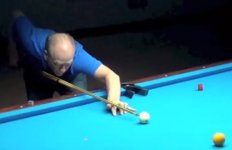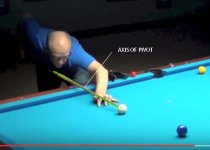This video of Stan's (Phoney Pocket Part 2) provided about the best view I've had thus far of the half tip pivot, which is usually obscured by the CB or too low res in other videos. https://www.youtube.com/watch?v=5wQysSywOxU
I recall previous suggestions over the years that this pivot does not actually take place with a fixed bridge, such that the axis or fulcrum is at the distance of the bridge V.
I overlapped the before and after pivot positions from both shots in the video. Note that there is a little distortion on shot 1, as the cue dropped, hence altering the perception of the cue line a little from that angle.
However, my estimation is that it is near to a parallel cue movement to CCB on the first shot, or at least a 25+ inch pivot axis.
On the second shot, which requires more cut, the pivot axis is about twice as long as the bridge, or approx 15 inches.
If the original perceptions were the same, the shorter pivot axis would explain a larger resultant cut on the second shot than achieved on the first cut shot.
I think this type of analysis is helpful in trying to replicate the system.
Note: This would be best presented as a 2 image gif, with cue lines overlaid for the before and after. I didn't have the time to do that. Perhaps others can attempt such from screen grabs and see what results they get.
Colin
I recall previous suggestions over the years that this pivot does not actually take place with a fixed bridge, such that the axis or fulcrum is at the distance of the bridge V.
I overlapped the before and after pivot positions from both shots in the video. Note that there is a little distortion on shot 1, as the cue dropped, hence altering the perception of the cue line a little from that angle.
However, my estimation is that it is near to a parallel cue movement to CCB on the first shot, or at least a 25+ inch pivot axis.
On the second shot, which requires more cut, the pivot axis is about twice as long as the bridge, or approx 15 inches.
If the original perceptions were the same, the shorter pivot axis would explain a larger resultant cut on the second shot than achieved on the first cut shot.
I think this type of analysis is helpful in trying to replicate the system.
Note: This would be best presented as a 2 image gif, with cue lines overlaid for the before and after. I didn't have the time to do that. Perhaps others can attempt such from screen grabs and see what results they get.
Colin
Attachments
Last edited:


